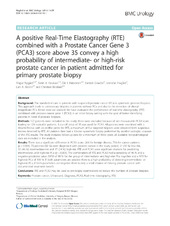| dc.contributor.author | Nygård, Yngve | en_US |
| dc.contributor.author | Haukaas, Svein A. | en_US |
| dc.contributor.author | Halvorsen, Ole J. | en_US |
| dc.contributor.author | Gravdal, Karsten | en_US |
| dc.contributor.author | Frugård, Jannicke | en_US |
| dc.contributor.author | Akslen, Lars A. | en_US |
| dc.contributor.author | Beisland, Christian | en_US |
| dc.date.accessioned | 2016-08-10T08:59:38Z | |
| dc.date.available | 2016-08-10T08:59:38Z | |
| dc.date.issued | 2016-07-08 | |
| dc.Published | BMC Urology 2016, 16(1):39 | eng |
| dc.identifier.issn | 1471-2490 | |
| dc.identifier.uri | https://hdl.handle.net/1956/12536 | |
| dc.description.abstract | Background: The standard of care in patients with suspected prostate cancer (PCa) is systematic prostate biopsies. This approach leads to unnecessary biopsies in patients without PCa and also to the detection of clinical insignificant PCa. Better tools are wanted. We have evaluated the performance of real-time elastography (RTE) combined with prostate cancer gene 3 (PCA3) in an initial biopsy setting with the goal of better identifying patients in need of prostate biopsies. Methods: 127 patients were included in this study; three were excluded because of not measureable PCA3 score leading to 124 evaluable patients. A cut-off value of 35 was used for PCA3. All patients were examined with a Hitachi Preirus with an endfire probe for RTE, a maximum of five targeted biopsies were obtained from suspicious lesions detected by RTE. All patients then had a 10-core systematic biopsy performed by another urologist unaware of the RTE results. The study includes follow-up data for a minimum of three years; all available histopathological data are included in the analysis. Results: There was a significant difference in PCA3 score: 26.6 for benign disease, 73.6 for cancer patients (p < 0.001). 70 patients (56 %) were diagnosed with prostate cancer in the study period, 21 (30 %) low-risk, 32 (46 %) intermediate-risk and 17 (24 %) high-risk. RTE and PCA3 were significant markers for predicting intermediate- and high-risk PCa (p = 0.001). The combination of RTE and PCA3 had a sensitivity of 96 % and a negative predictive value (NPV) of 90 % for the group of intermediate- and high-risk PCa together and a NPV for high-risk PCa of 100 %. If both parameters are positive there is a high probability of detecting intermediate- or high-risk PCa, if both parameters are negative there is only a small chance of missing prostate cancer with documented treatment benefit. Conclusions: RTE and PCA3 may be used as pre-biopsy examinations to reduce the number of prostate biopsies. | en_US |
| dc.language.iso | eng | eng |
| dc.publisher | BioMed Central | eng |
| dc.relation.ispartof | <a href="http://hdl.handle.net/1956/12840" target="_blank">On the diagnosis of early stage Prostate Cancer with an emphasis on Prostate Cancer Gene 3 (PCA3) and Real-Time Elastography (RTE)</a> | |
| dc.rights | Attribution CC BY | eng |
| dc.rights.uri | http://creativecommons.org/licenses/by/4.0/ | eng |
| dc.subject | Prostate cancer | eng |
| dc.subject | Ultrasound | eng |
| dc.subject | PCA3 | eng |
| dc.subject | Real-time elastography | eng |
| dc.subject | RTE | eng |
| dc.title | A positive Real-Time Elastography (RTE) combined with a Prostate Cancer Gene 3 (PCA3) score above 35 convey a high probability of intermediate- or high-risk prostate cancer in patient admitted for primary prostate biopsy | en_US |
| dc.type | Peer reviewed | |
| dc.type | Journal article | |
| dc.date.updated | 2016-07-08T16:03:05Z | |
| dc.description.version | publishedVersion | en_US |
| dc.rights.holder | Copyright The Author(s). | |
| dc.identifier.doi | https://doi.org/10.1186/s12894-016-0159-1 | |

